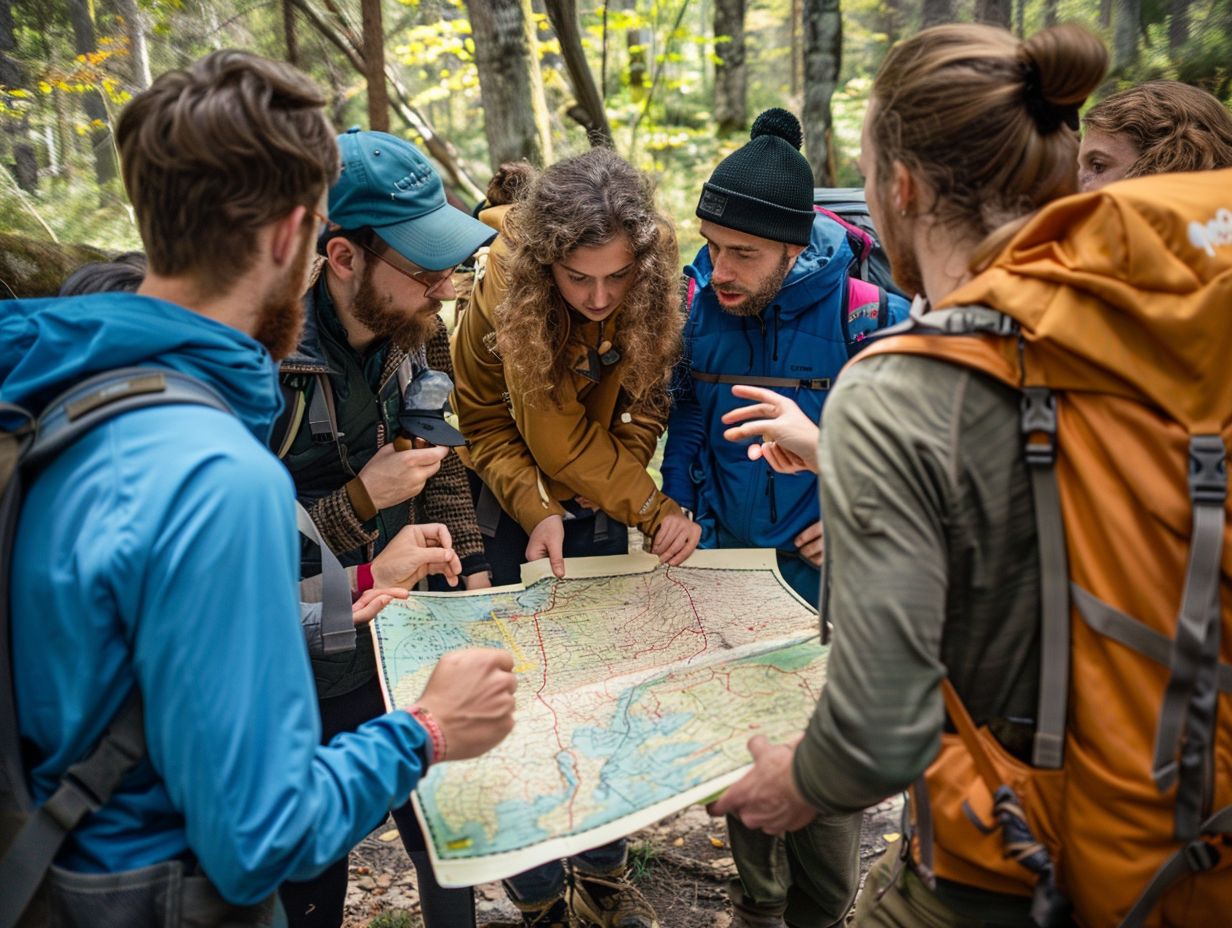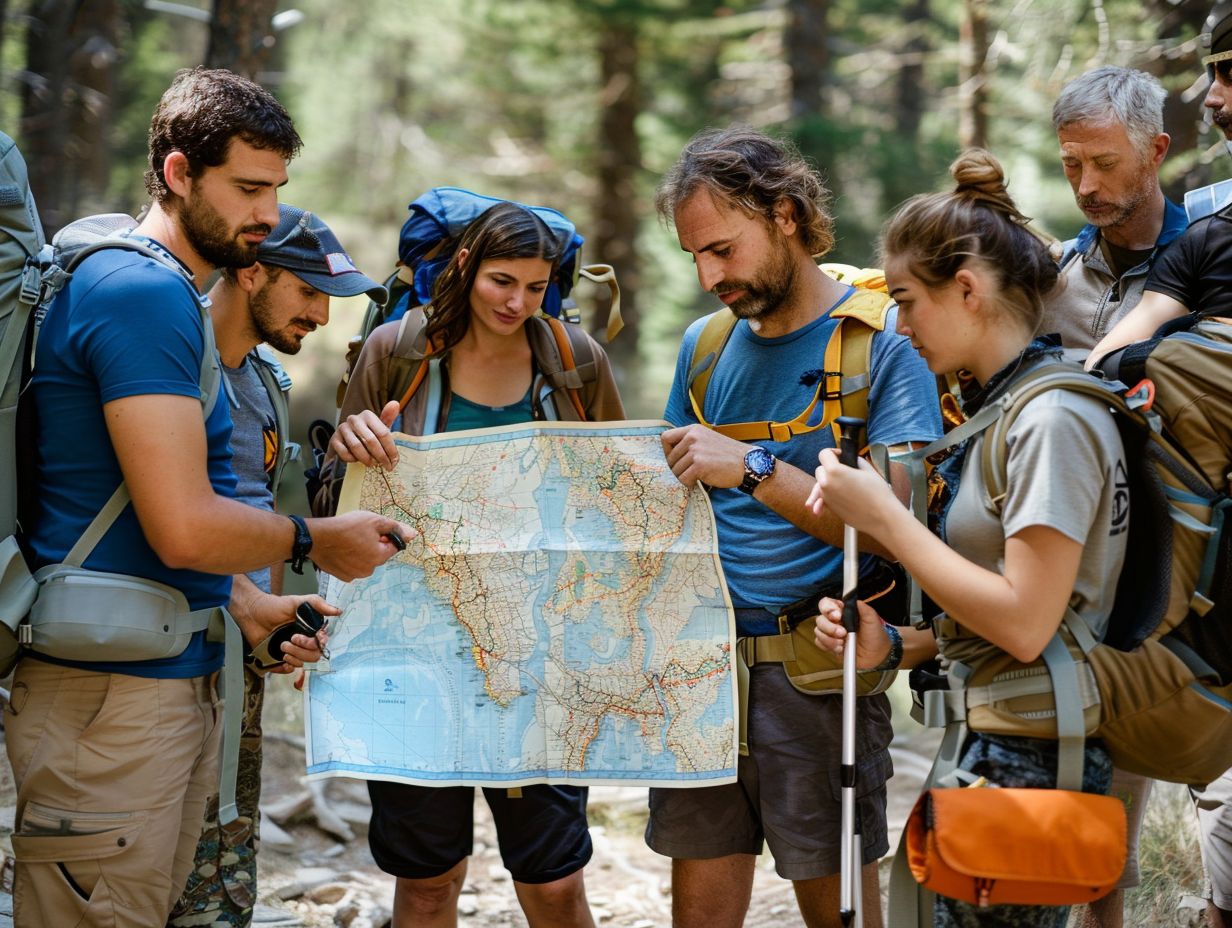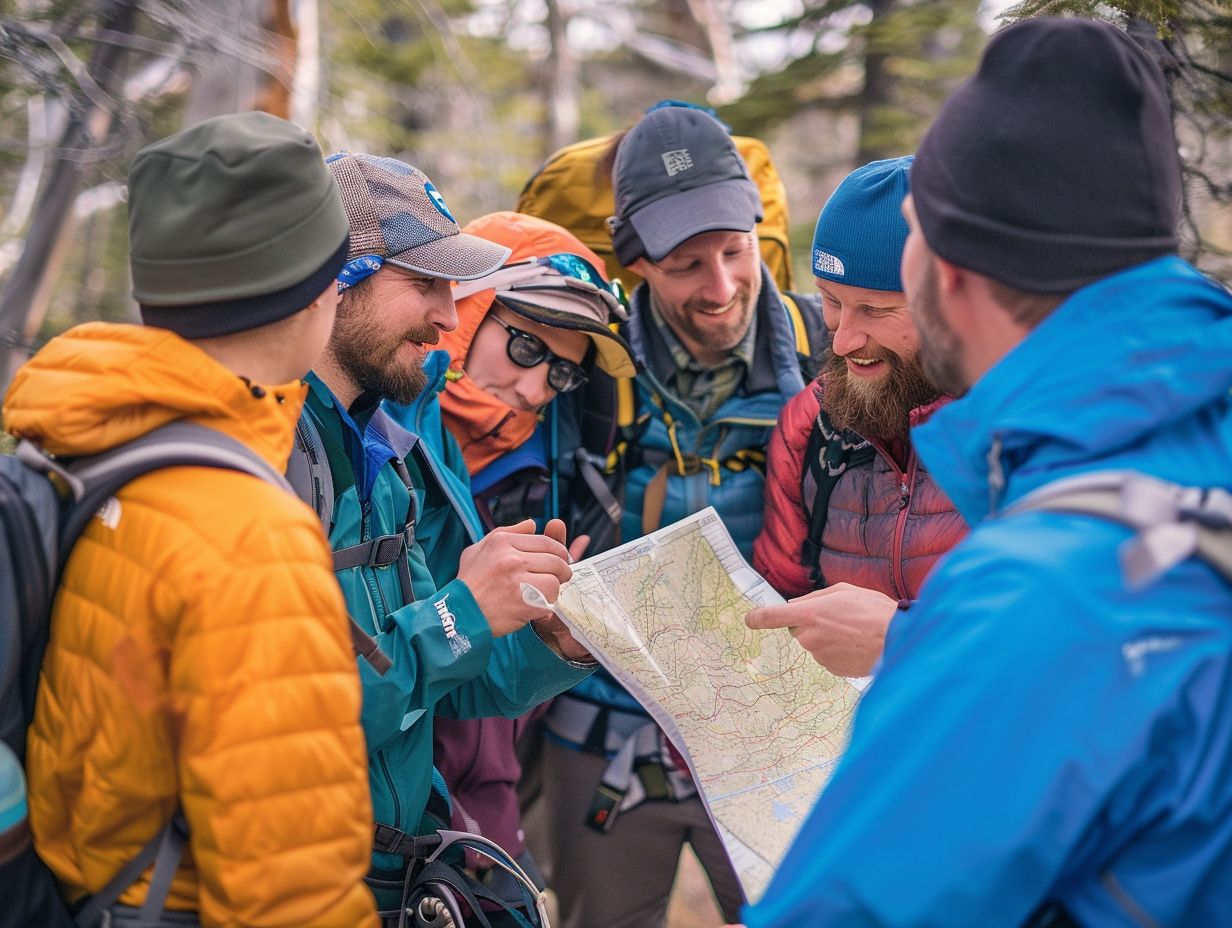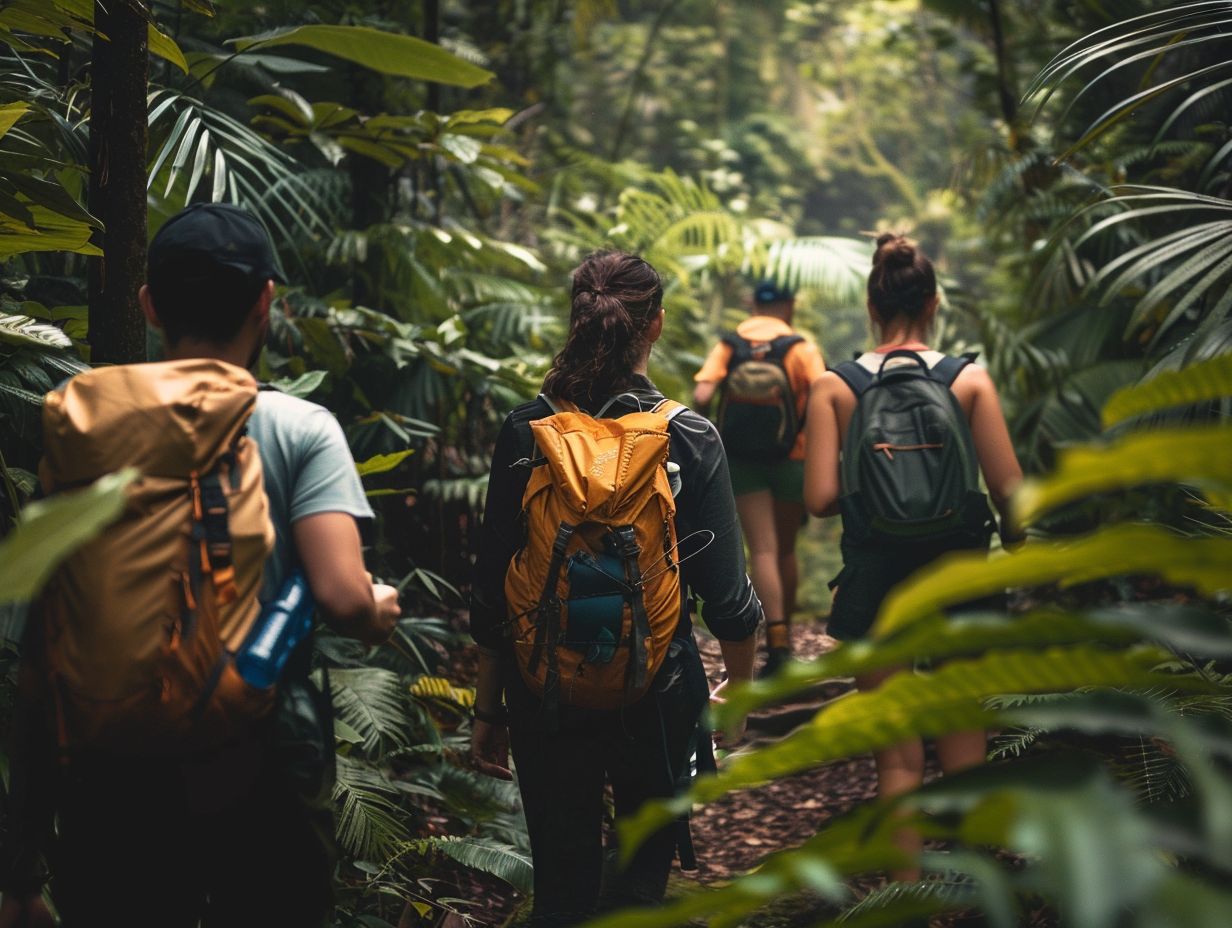

Vaibhav
- Categories: Hiking
Planning a hike with a large group can be a rewarding and memorable experience, but it requires careful consideration and preparation. Assess the physical abilities and experience levels of group members, choose the right hiking destination, and pack essential items.
We will discuss key factors to consider before planning a hike with a large group, how to choose a hiking destination, essential items to bring, and safety measures to take during the hike. So lace up your boots and get ready for an adventure with your friends and family!
Key Takeaways:

- Consider group size, physical abilities, experience, time, distance, weather, and terrain before planning a hike with a large group.
- Choose a suitable hiking destination by researching trails, accessibility, amenities, group size restrictions, and difficulty level.
- Prioritize safety by bringing essential items, creating a detailed itinerary, establishing a meeting point and time, and monitoring group members’ well-being during the hike.
Why Plan a Hike with a Large Group?
Organising a group hike can greatly enrich the outdoor excursion by integrating a variety of enjoyable challenges that assess not only physical capabilities but also interpersonal skills, rendering it a fulfilling adventure for all participants.
What Factors to Consider Before Planning a Hike with a Large Group?
Ahead of organising a hiking excursion with a sizable group, it is imperative to take into account a range of factors. These factors include the physical capabilities of all group participants, logistical requirements, prevailing weather conditions, and potential environmental risks. This comprehensive consideration is essential in order to guarantee a safe and enjoyable outing.
1. Group Size
Determining the size of the group is a crucial initial step in planning a hike, as it plays a pivotal role in shaping logistical considerations such as transport arrangements, campsite capacity, and the dynamics within the group.
In the case of smaller, more intimate hiking excursions, a group size ranging between 2 to 4 individuals might be deemed optimal. This configuration allows for enhanced flexibility and facilitates streamlined decision-making processes.
Conversely, when dealing with larger groups comprising 10 or more hikers, the potential benefits include a heightened sense of communal camaraderie and the opportunity to share experiences collectively. However, leading and coordinating such sizeable groups necessitates a more structured approach to leadership and communication to ensure cohesion and safety.
Managing larger groups presents challenges, such as varying hiking speeds and divergent preferences in route selection. Conversely, smaller groups typically encounter smoother logistical coordination, expedited decision-making processes, and increased adaptability to swiftly respond to evolving circumstances during the hiking expedition.
2. Physical Abilities of Group Members
It is crucial to take into consideration the physical capabilities of all group members to ensure that the hike is appropriate and enjoyable for all participants.
Conducting an evaluation of the physical fitness levels of individuals before commencing the hike enables the customisation of the route to accommodate diverse capabilities. Factors such as distance, elevation, terrain, and potential obstacles along the trail should be carefully considered.
Strategic planning of rest stops and offering alternatives for shorter or more challenging routes can address individual requirements. Anticipating unforeseen physical obstacles, such as injuries or fatigue, by carrying necessary first aid provisions and remaining vigilant for signs of distress among group members, contributes to a secure and successful hiking excursion.
3. Experience Level of Group Members
It is imperative to consider the varied experience levels of group members, ranging from novice hikers to seasoned outdoor enthusiasts, when planning activities to ensure appropriateness and safety.
Adapting the routes and activities to accommodate the diverse skill sets present within the group can enhance the inclusivity and overall enjoyment of the outdoor experience for all participants.
For individuals new to hiking, it is crucial to focus on simpler trails and shorter distances to allow for the gradual development of confidence and stamina. Conversely, experienced hikers may prefer more challenging terrains and longer hikes that test their capabilities.
Conducting skills workshops or informative sessions can also prove advantageous in providing novice hikers with essential knowledge on navigation techniques, gear selection, first aid procedures, and outdoor etiquette. This proactive approach not only elevates safety standards but also cultivates a sense of camaraderie among group members.
4. Time and Distance of Hike
The duration, distance, and elevation gain of the hike should be meticulously planned to align with the overall fitness and experience levels of the group. When determining the suitable duration and distance for the hike, it is crucial to take into account the fitness levels of the group members and the complexity of the terrain.
The elevation gain should also be considered, as steep ascents will necessitate additional time and effort. As a general guideline, estimating approximately 2-3 miles per hour on flat terrain is recommended, with adjustments made based on the incline.
Strategic planning of rest breaks is essential in ensuring the comfort and energy levels of all participants. It is preferable to take frequent short breaks rather than pushing too hard without adequate rest. It is important to listen to one’s body and communicate effectively with others in the group to guarantee the safety and enjoyment of everyone involved.
5. Weather and Terrain
Weather and terrain constitute crucial elements that can profoundly influence the safety and enjoyment of a hiking expedition, necessitating meticulous preparation and adaptability in strategising. It is imperative to have a comprehensive understanding of how to interpret weather predictions before commencing a hike to anticipate potential alterations in conditions.
To achieve this, individuals should utilise dependable sources, such as weather websites, applications, or local ranger stations, to remain updated and informed.
Furthermore, it is recommended to acquaint oneself with the topography of the specified hiking route to adequately prepare for any encountered challenges. This involves being cognisant of plausible environmental threats, such as steep inclines, rugged paths, or unforeseen weather fluctuations.
Equipping oneself with appropriate gear, such as layered clothing, a fully stocked first aid kit, an ample supply of water, and sustaining snacks, is paramount. Furthermore, it is advised to trust one’s instincts and make necessary adjustments to the initial plans when confronting unexpected circumstances.
How to Choose a Hiking Destination for a Large Group?

Choosing a suitable hiking destination for a large group requires comprehensive research into different trails, assessment of accessibility and facilities, checking group size limitations, and evaluating difficulty levels to match the abilities and preferences of the group.
1. Research Different Hiking Trails
Conducting research on different hiking trails, such as the Manistee River Trail in Michigan, can facilitate the selection of a route that aligns most effectively with the group’s preferences and capabilities.
By exploring a variety of sources for trail-related information, hikers can acquire valuable insights into factors such as trail length, level of difficulty, and the scenic beauty characteristic of different routes. Digital resources, such as the Outside+ app, offer a convenient means of accessing detailed trail maps, reviews, and expert recommendations.
Taking these considerations into account assumes paramount importance in the orchestration of a successful hiking excursion, ensuring that the chosen trail corresponds appropriately with the group’s physical fitness and desired experiential outcome.
Whether in pursuit of a tranquil amble through picturesque landscapes or a demanding trek yielding breathtaking vistas, meticulous research serves to enrich the overall adventure.
2. Consider Accessibility and Amenities
When organising a hike for a large group, it is imperative to consider accessibility and amenities, such as available shelters and campsite options.
A thorough evaluation of the hiking destination’s accessibility is crucial to guarantee that all group members can easily reach the trailhead.
Conducting research on transportation alternatives, including public transport availability or parking facilities, can assist in determining the most convenient means of travel. Additionally, assessing trailhead amenities, such as toilet facilities and information boards, can significantly improve the overall hiking experience.
In the selection of a campsite, it is essential to opt for one that provides adequate amenities like water sources, designated fire pits, and level ground for tent placement. This ensures the group’s comfort and safety throughout the journey.
3. Check for Group Size Restrictions
Ensuring compliance with group size restrictions and acquiring the necessary permits and reservations are fundamental aspects to consider during the preparation phase of a large group hiking expedition.
In advance of commencing the hiking venture, it is imperative to conduct thorough research on the specific protocols and regulations stipulated by each hiking destination regarding group capacities. Familiarising oneself with these constraints is essential to prevent legal ramifications and ensure strict adherence to the prescribed guidelines.
Promptly obtaining permits and securing reservations is vital in confirming your group’s access and accommodations along the designated trail. By adhering to these protocols, individuals not only conform to the regulations of the park or trail but also contribute to the conservation endeavours and sustainable management of the respective natural environs.
4. Consider the Difficulty Level
It is essential to consider the difficulty level of the trail when planning a hike, as this evaluation is crucial in aligning the route with the physical capabilities of the group and ensuring a favourable reward-to-effort ratio.
One primary factor to evaluate the trail difficulty is the elevation gain. Trails with steep inclines and descents may present a greater challenge in comparison to those with more gradual ascents.
Additionally, the terrain type significantly influences the difficulty level, with trails featuring rugged terrain such as rocks, roots, or narrow paths being more demanding. The length of the trail is also a critical aspect to take into account, as longer trails may necessitate more stamina and endurance.
To select a trail that provides a harmonious balance of challenge and enjoyment, it is advisable to opt for a moderate difficulty level that accommodates all members of the group effectively.
What are the Essential Items to Bring for a Hike with a Large Group?
Ensuring safety and preparedness during a hike with a large group necessitates the acquisition of essential items. These items include:
- navigation tools
- a first aid kit
- additional food and water supplies
- communication devices
- emergency shelter
1. Navigation Tools
Navigation tools, including maps, compasses, and GPS devices, are essential equipment to ensure the group remains on the designated route and avoids the risk of becoming disorientated.
The availability of a diverse range of navigation aids not only enhances the accuracy of navigation but also offers redundancy in the event of one tool malfunctioning. By integrating conventional tools such as maps and compasses with contemporary technology like GPS devices, hikers can establish a comprehensive navigation system.
It is imperative for the group leader to acquaint themselves with the routes in advance, strategically plan waypoints, and effectively lead the team. Clear communication and routine map verifications can mitigate the possibility of incorrect turns and contribute to the overall safety of all participants throughout the trek.
2. First Aid Kit
A comprehensive first aid kit, which includes supplies for common hiking injuries like blisters, is an essential component of group gear that can significantly enhance the management of emergencies.
It is imperative to stock the first aid kit with essentials such as adhesive plasters, dressings, antiseptic wipes, scissors, and painkillers. Proficiency in basic first aid skills, including CPR and wound care, can prove to be invaluable during outdoor excursions.
Plus the first aid kit, it is recommended that each member carries personal medical information detailing allergies, medication, and emergency contacts. In case of a medical emergency, prompt and composed communication within the group is crucial for ensuring timely assistance and potentially saving lives.
3. Extra Food and Water

It is imperative to carry additional food and water supplies, including snacks and essential meal planning items, to ensure that the group maintains adequate energy levels and hydration throughout the hiking expedition.
When considering the selection of optimal food choices for hiking, lightweight, high-energy snacks are recommended. Granola bars, trail mix, nuts, and dried fruits are excellent options as they provide a quick energy boost without adding significant weight to your rucksack.
Additionally, items such as energy gels, nut butter packets, or beef jerky can serve as convenient sources of protein and sustenance. Planning for surplus consumables is advisable to prepare for unforeseen circumstances or prolonged trekking durations, guaranteeing that all individuals are sufficiently nourished for the journey ahead.
4. Communication Devices
To maintain contact within a group and make informed decisions during emergencies, it is imperative to utilise effective communication devices such as radios or satellite phones.
In the challenging topography of backcountry settings, where cellular connectivity is often unavailable, these communication tools assume a critical role in coordinating group activities and ensuring the safety of all individuals involved.
Radios enable the dissemination of real-time updates concerning trail conditions and potential hazards, whilst satellite phones serve as a vital link to emergency services when encountering unforeseen circumstances.
It is essential for every member of the hiking group to comprehend their responsibility in upholding open communication channels, be it by carrying a communication device, monitoring designated channels, or familiarising themselves with the proper utilisation of emergency signals in the event of separation.
5. Emergency Shelter
Emergency shelter options such as the Lunar Solo or Skyscape Scout play a vital role in providing protection against adverse weather conditions and unforeseen overnight shelter needs. These shelters are available in a variety of styles and designs to meet the diverse requirements of outdoor enthusiasts.
It is imperative to select a shelter that is lightweight, durable, and simple to assemble. When including an emergency shelter in one’s gear, it is important to pack essential items such as a sleeping bag, extra clothing, food, water, and a first aid kit to enhance survival chances in unexpected situations.
Being equipped with the appropriate gear can significantly impact safety and comfort levels when confronted with sudden weather changes or emergency scenarios in the wilderness.
How to Plan and Communicate the Hike Itinerary to the Group?
The process of outlining and communicating the hiking itinerary to the group requires the development of a comprehensive plan, dissemination of crucial information, and the establishment of a precise meeting location and time. This is essential to facilitate seamless logistics and coordination.
1. Create a Detailed Itinerary
Developing a comprehensive itinerary that outlines the route, timing, and logistical arrangements is essential for maintaining organization and adherence to schedule during the hiking expedition.
The itinerary should include essential checkpoints along the trail where the group can meet, assess available supplies, and ensure the presence of all participants.
The inclusion of designated rest intervals in the schedule is crucial to maintain energy levels and prevent tiredness. It is advisable to include estimated timeframes for reaching each checkpoint, considering the complexity of the terrain and the group’s speed.
It is vital to allow for flexibility within the plan to accommodate unexpected delays or changes due to changing weather conditions. By creating a carefully planned itinerary, one can enhance the hiking experience for all individuals involved.
2. Share the Itinerary and Important Details with the Group
Sharing the itinerary and relevant details with the group is essential to ensure that all individuals are well-informed about their responsibilities, the designated meeting point, and the overall plan.
One efficient approach for disseminating the itinerary is utilising digital tools such as the Outside+ app, which facilitates easy access to schedules and updates.
Effective and transparent communication plays a crucial role in guaranteeing alignment among all group members and clarity regarding their respective roles.
This proactive communication strategy helps in averting confusion, reducing the likelihood of misunderstandings, and fostering a seamless progression of activities throughout the trip.
When each participant comprehensively understands their assignments and the overarching agenda, it cultivates a sense of accountability and collaboration within the group.
3. Establish a Meeting Point and Time
It is imperative to establish a clear meeting point and time to coordinate the group’s departure effectively and ensure the accountability of all participants before commencing the hike.
When selecting a meeting point, it is advisable to choose a location that is easily identifiable and convenient for all individuals involved. This could entail opting for a well-known landmark or a designated area with ample parking facilities.
Punctuality significantly contributes to the successful execution of the hiking trip; therefore, it is recommended to emphasise the importance of arriving on time to prevent any potential delays.
Clear and efficient communication is paramount – it is essential to ensure that all members possess the requisite information and understand how to access the designated meeting point.
By following these steps, a seamless and organised commencement of the hiking adventure can be achieved, enhancing the overall experience for all participants.
What Safety Measures to Take During the Hike?
Implementing safety protocols during the hike, such as:
- maintaining group cohesion,
- adhering to Leave No Trace principles,
- monitoring both physical and mental well-being, and
- preparing for contingencies,
is imperative to guarantee a secure and conscientious outdoor excursion.
1. Stay Together as a Group

Maintaining cohesion within the group and fostering coordination among hiking companions represent essential safety precautions during a hiking expedition.
When all members remain together, it not only guarantees that no individual is inadvertently left behind or misplaced but also facilitates prompt responses in the event of emergencies. Adopting the buddy system, wherein each hiker is paired with a partner, significantly heightens safety levels.
Regular headcounts conducted at predetermined checkpoints provide a straightforward yet invaluable method to ensure the group’s unity. This protocol not only nurtures a sense of camaraderie but also enables hikers to offer mutual assistance throughout the journey, thereby enhancing the overall safety and enjoyment of the experience.
2. Follow Leave No Trace Principles
Adherence to the Leave No Trace principles, including the pack it out rule, is essential for reducing the environmental footprint and conserving the natural splendour of hiking destinations. By abiding by these principles, hikers can ensure minimal evidence of their presence while enjoying outdoor excursions.
When selecting a campsite, it is imperative to opt for a resilient surface, such as established campsites or rock, gravel, or sand areas, to mitigate harm to delicate ecosystems. Sound waste management practices entail the proper disposal of all waste, including food remnants and biodegradable materials, to prevent pollution and disruption of wildlife habitats.
Implementation of methods like burying human waste at a distance of at least 200 feet from water sources and using biodegradable soap can further diminish ecological impact.
3. Monitor Group Members’ Physical and Mental State
The monitoring of the physical and mental condition of group members is a collective responsibility aimed at ensuring the well-being and safety of all individuals during the hiking expedition.
Regularly checking in with each other throughout the journey can offer valuable insights into how each person is managing the experience. Establishing open lines of communication within the group is vital to promptly address any concerns or discomfort that may arise.
It is imperative to carry a well-equipped first aid kit to facilitate an immediate response to any physical injuries or medical emergencies that may occur.
Additionally, being prepared to address psychological challenges, such as feelings of fear or anxiety, is equally crucial in maintaining a supportive and positive hiking environment.
4. Be Prepared for Emergencies
Being prepared for emergencies during a hike is crucial for effectively managing unforeseen situations. This entails having the appropriate preparation and safety measures in place, including communication devices and knowledge of emergency services.
Possessing essential gear such as a first aid kit, torch, extra food and water, as well as navigation tools, can significantly enhance safety and increase the likelihood of survival in unexpected events.
Furthermore, it is imperative to communicate your hike plans and expected return time with a designated individual, serving as a crucial backup in the event of an emergency. Additionally, having alternate routes planned and understanding potential risks in the area can offer additional security and flexibility, enabling hikers to adeptly adjust to changing circumstances.
Frequently Asked Questions
What are some tips for planning a hike with a large group?
1. Start by choosing a suitable trail for all skill levels and physical abilities within the group.
2. Set a realistic distance and pace for the hike.
3. Consider the weather, time of day, and any potential hazards on the trail.
4. Plan for breaks and designated meeting points along the way.
5. Communicate the plan and expectations to the group beforehand.
6. Assign roles and responsibilities to group members, such as a leader, navigation, and first aid.
How do I keep everyone in the group safe during the hike?
1. Make sure everyone has proper gear, including appropriate clothing, shoes, and enough water and snacks.
2. Bring a map and know how to read it or have a GPS device.
3. Have a first aid kit and know basic first aid.
4. Follow Leave No Trace principles and respect the environment.
5. Keep an eye on the group and stay together, especially when encountering difficult terrain.
6. Be prepared for emergency situations and have a plan in case someone gets injured or lost.
What are some potential challenges I should be aware of when planning a hike with a large group?
1. Lack of coordination and communication among group members.
2. Differences in skill levels and physical abilities.
3. Unforeseen events, such as unexpected weather changes or injuries.
4. Difficulty in finding a suitable trail for a large group.
5. Time constraints and difficulty in keeping the group on schedule.
6. Limited resources and gear for a large group.
How can I involve the group in the planning process and make sure everyone is on board?
1. Ask for suggestions and preferences from the group members.
2. Create a shared document or group chat to discuss and finalise the plan.
3. Consider everyone’s needs and limitations.
4. Encourage open communication and address any concerns or conflicts.
5. Have a backup plan in case of any last-minute changes.
6. Make sure all group members are aware of the plan and their responsibilities.
How do I handle unexpected situations or changes during the hike?
1. Stay calm and assess the situation before making any decisions.
2. Communicate with the group and ask for input and suggestions.
3. Consider the safety and well-being of the group as a whole.
4. Adjust the plan accordingly and make sure everyone is on the same page.
5. Be flexible and have a backup plan in case of any major changes.
6. Learn from the experience and use it to improve future hikes with the group.
What are some important items to include on a hiking checklist for a large group?
1. Appropriate clothing and footwear for the expected weather conditions.
2. Enough water and snacks for the entire group.
3. Navigation tools, such as a map and compass or GPS device.
4. First aid kit and knowledge of basic first aid.
5. Emergency supplies, such as a whistle, flashlight, and emergency shelter.
6. Communication devices, such as a fully charged phone or two-way radios.
Share:
By submitting your email address, you are agreeing to receive marketing emails from theexpertcamper.co.uk.
We’ll never share your email address and you can unsubscribe at any time. Privacy policy
Related Posts

A Seasonal Guide To Hiking In The Peak District
Are you ready to lace up your hiking boots and explore the stunning landscapes of the Peak District? This seasonal guide will take you through

Hiking Challenges Preparing For Your First Ultrahike
Are you ready to take your hiking adventures to the next level? Ultra-hiking offers a unique combination of physical and mental challenges, breathtaking scenery, and

Ecofriendly Hiking Tips For Sustainable Adventures
Are you an outdoor enthusiast looking to minimise your impact on the environment while enjoying the great outdoors? Eco-friendly hiking is the perfect solution! We

The Best Hiking Trails For Experiencing UK Wildlife
When exploring the picturesque hiking trails of the UK, you can expect to encounter a diverse array of wildlife. From majestic birds soaring overhead to

Wildflower Walks The Best Trails For Nature Lovers
Are you a nature lover looking to embark on a wildflower walk? Explore the best trails for wildflower walks, including [Trail Name 1], [Trail Name

























